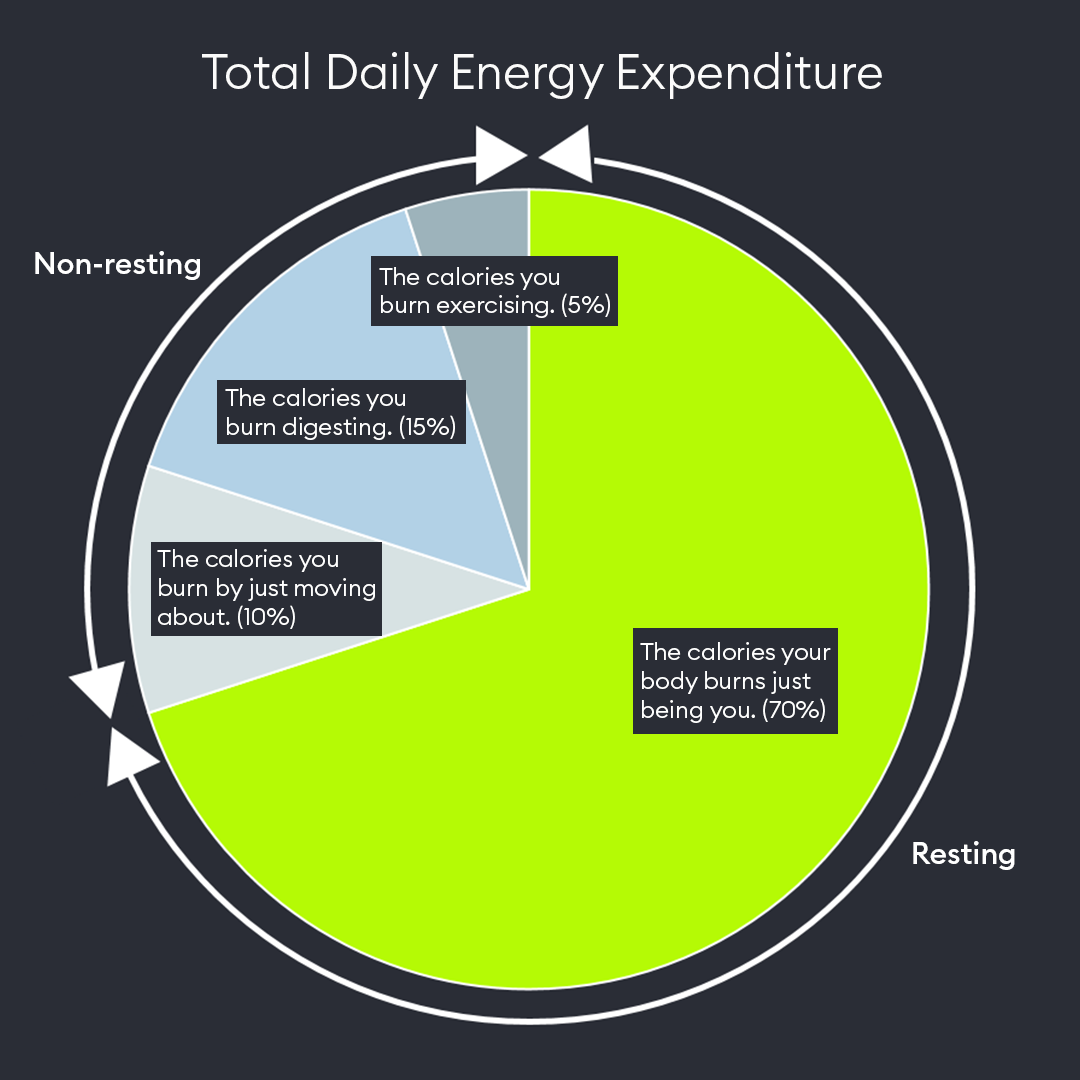If you’re on a weight loss journey or ever have been before, you’ll be very familiar with a calorie deficit. Wiping away the fad diets and workouts that promise to ‘blast belly fat’, there’s a very simple science behind weight loss.
To lose body fat, you need to burn more energy than you consume over a prolonged period. It doesn’t matter what you eat or how you burn it; keeping yourself in the negative when it comes to energy in vs out will lead to weight loss.
In reality, it’s not that easy. We’re all busy human beings. Our lifestyles, relationships with food, relationships with exercise and many other factors make this simple equation pretty tricky to execute. Being told ‘calorie deficit’ over and over again doesn’t really help with this.
So, let’s understand what a calorie deficit actually is and how to create one for weight loss. If that’s what you want to do.
What is a calorie?
A calorie is a unit of measurement for energy. Every single food can be defined by a number of calories, and so can physical activity.
When taken into the body, this energy is either used immediately, kept in your glycogen stores for later, or converted to fat. If it’s not used immediately, the body converts and keeps the energy in your glycogen stores. Glycogen is easy for your body to access and is what keeps us going between meals. Our glycogen stores have a maximum capacity. When they’re full, any additional energy gets converted and stored in our body’s fat cells. When our glycogen stores are depleted, our body turns to its fat stores for energy.
That’s why we don’t lose and gain weight constantly over a day or a couple of days. Weight loss happens when we’re consistently using up our fat stores due to a lack of calories available to us.
How many calories do I need?
Another important question that it’s difficult to answer. Daily energy intake is dependent on the individual. The recommended numbers from the NHS are 2000 calories for women and 2500 calories for men. But age, activity level, metabolism, hormones, genetics, and many other factors can have an impact on precisely what is required each day to maintain your current weight.
It helps to understand what you use your calories for each day. TDEE stands for total daily energy expenditure and describes the total amount of calories your body needs to carry out everything it needs to do in a day. It can be broken down into different sections that explain how it’s used.
First, you have your resting energy expenditure, which is your BMR or basal metabolic rate. Your BMR is the amount of energy your body needs to carry out its functions to sustain life. Breathing, circulation, nutrient processing, cell production. All the things going on that we can’t even control make up the majority of our TDEE.
Next, you have non-resting energy expenditure. You guessed it. It describes all things we do when not resting that burn energy and it can be broken down into different categories:
- The thermic effect of food accounts for around 15% of this. Just digesting, processing and converting food requires energy from the body.
- All the physical activity and movement we undertake that’s not us purposely exercising accounts for around 10% of this total. Standing, sitting, walking, reaching, lifting. Anytime we move a muscle, we’re contributing to this. You’ll hear it referred to as NEAT, which stands for non-exercise activity thermogenesis.
- Then, there’s your purposeful exercise. EAT stands for exercise activity thermogenesis and describes the energy expenditure that happens when we engage in planned exercise or sport. At the gym, on a run or wherever.
What is helpful to understand is the percentage of each of these components as a part of our TDEE. From the chart below, you can see that our BMR makes up most of the energy we expend, whereas our EAT only accounts for around 5%.
Critically, our NEAT often accounts for double the amount of calorie burn than EAT. That’s because general movement is easier to maintain and do for more extended periods. The single most impactful way you can burn more calories is to move more throughout the day. That’s where to 10,000 steps thing comes from.

How to create a calorie deficit?
There are only directly three things you can control when it comes to creating a caloric deficit.
Your intake is much goes into your body will determine how much needs to come out to be in a calorie deficit. For example, if you’re an average male and need 2500 calories per day to maintain it, consuming 2000 calories for 7 days will result in 1 pound of fat lost.
Your NEAT is why many calorie calculators ask you for your average activity level when calculating how many calories you might need. If you walk lots each day, have a physically demanding job, or stay up on your feet for long periods, you’ll burn more calories from NEAT than a person with a desk job. Top tip: general movement has a considerable impact. If you have a fitness watch, you’ll know that already.
Your EAT is the exercise you manage to fit into your schedule. Arguably the most challenging part type to fit in and to calculate accurately. Exercising in this way is arguably more beneficial fitness than pure calorie burn.
How big should my calorie deficit be?
There’s a reason people say that sustainable weight loss plans are the only ones that work. Because it’s true. Creating enormous caloric deficits will leave you weak and tired and, worse, hangry. They are also nearly impossible to sustain. What’s worse is that the impact on your feeding cycles and relationship with food that happen off the back of these attempts can often result in an overall increase of calories soon after, undoing any weight loss achieved.
Let’s go back to the maths. To start, you’ll also need to know how many calories you need per day to maintain your current weight. You can use lots of handy calculators to predict this, which rely on data such as your age, gender, height, current weight, and activity levels.
Pick a deficit each day that feels sustainable and something you can maintain for long periods without impacting your quality of life or your lifestyle. Some rough guidelines: 1000 is probably too much. 100 is perhaps too little.
There are around 3500 calories in 1 pound of fat. That means you need to create a deficit of 3500 calories from your maintenance calories to lose this amount of weight. A deficit of 500 calories would lead to a weight loss rate of 1 pound per week. A deficit of 250 calories would lead to a weight loss rate of 1 pound every two weeks. Something within this range is probably a realistic and sustainable target.
Ok, but how do I apply a calorie deficit to real life?
This is the hard part. It’s all well and good knowing the numbers but putting that information into real life is not straightforward. But some handy tips can help you get started.
Tip 1: Look at your week, not your day
We’re all guilty of a similar pattern of behaviour over the week. We’re good at eating less and moving more on Monday, Tuesday, and Wednesday. On Thursday, we might treat ourselves to a bit more dessert, but we won’t overdo it. On Friday night, we drink more than we expected. Saturday leads to multiple meals out, and by Sunday, the calorie counting has gone out the window. Any work we did during the week is undone at the weekend, even if we don’t notice.
It’s normal. And it’s okay. Treating ourselves and eating more on some days than others is reflective of a healthy lifestyle. Our appetite fluctuates day to day, and naturally, we regulate throughout the week. But if you’re trying to lose weight, this can be a bit unnerving. It just means you might need to think ahead a little bit and consider your plans for the week and not just the day.
Plan larger calorie deficits on the days it is easier to do so. Allow for a day without a calorie deficit when you know you have some social plans you don’t want to miss out on. Make it work across the week and make time for the lifestyle you love.
Tip 2: Don’t underestimate your NEAT
We’ve said it before, and we’ll say it again. It’s the factor that people often don’t pay much attention to. But increasing your daily NEAT can help to increase your caloric deficit without you even realising, which is where the trend of the 10,000 daily step count comes from. Although that number isn’t the magical solution to weight loss, it’s grounded in a strategy that helps your efforts. Take the stairs. Get some steps in at lunch. Stand during meetings. Add on a walk to the end of your commute. All these little things can begin to add up if they become habits and routines.
Tip 3: Think long term
A weight-loss journey can be a really positive one. But it should never impact your desired lifestyle or quality of life. Be realistic with the changes you can and want to make.
In the short term, make sure you’re still taking joy in your weekdays and allowing yourself to be flexible at weekends. Socialise. Exercise for fun. Eat the foods you love. Restriction and misery shouldn’t be a part of your weight loss journey.
In the long term, be aware that the total number of calories you will need will also decrease as your weight reduces. If your current maintenance calories are 2700 per day and you reduce that to 2000 per day to achieve your goal weight, your daily calories to remain at your new weight won’t be 2700 anymore. You’ll probably need a little less than that. Just something to be aware of.
Tip 4: Be flexible
Life is busy, demanding and can be very fast-paced. It’s hard to fit fitness in. Being flexible helps you to keep that work, life, fitness balance in check.
Give yourself the right tools to ensure exercise plays a positive part in your life, how and when you want it. If multi-gym access and online fitness sound like it might do the trick, you know exactly who to come to!



